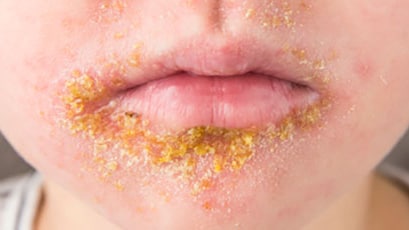Key points
- Both Streptococcus pyogenes and Staphylococcus aureus can cause non-bullous impetigo.
- Typically, impetigo features papules that evolve into pustules and break down into crusty lesions.
- Diagnosed by physical examination, impetigo is treated with oral or topical antibiotics that target both bacteria.
- Antibiotic treatment and covering lesions are key prevention strategies.
- Follow recommended guidelines when caring for patients with impetigo.

Cause
Impetigo (also called pyoderma) is a superficial bacterial skin infection caused by either S. pyogenes or S. aureus. This page focuses solely on infections caused by S. pyogenes, which are also called group A Streptococcus (group A strep bacteria).
The incubation period of impetigo is about 10 days1.
Types
Impetigo can be bullous or non-bullous.
Bullous: Caused by toxin-producing S. aureus
Non-bullous: Caused by S. aureus, S. pyogenes, or both
Non-bullous impetigo is also called impetigo contagiosa.
Risk factors
Anyone can get impetigo, but certain factors increase the risk of infection.
Age
Impetigo is most common among children 2 through 5 years of age.
Breaks in the skin
Scabies infections and activities that result in cutaneous cuts or abrasions increase the risk of impetigo.
Close contact
Contact with someone else with impetigo is the most common risk factor for infection. This includes contact with drainage from impetigo lesions.
Hygiene
Poor personal hygiene, including lack of proper hand, face, or body hygiene, can increase someone's risk of impetigo.
Weather and climate
Impetigo can occur in any climate and at any time of year. It's more common during the summer in temperate climates and in tropical or subtropical locations.
Clinical features

Not everyone whose skin becomes colonized will develop impetigo.
For those who do, they typically develop multiple skin lesions.
Lesion progression
The skin lesions progress in the following way:
- Begin as papules
- Evolve to pustules
- Break down into thick, adherent crusty lesions
The crusts are typically golden or "honey colored."
Lesion location
The lesions usually appear on exposed areas of the body. They most commonly appear on the face and extremities but can occur anywhere on the body.
Diagnosis
Impetigo is diagnosed by physical examination.
Physical examination cannot reliably differentiate between streptococcal and staphylococcal non-bullous impetigo.
Bacterial cause rarely determined
Laboratory testing isn't necessary nor routinely performed in clinical practice. However, Gram stain or culture of the exudate or pus from an impetigo lesion can identify the bacterial cause.
Treatment
Antibiotics are used to treat impetigo:
- Oral: Use with multiple lesions
- Topical (mupirocin or retapamulin): Use with only a few lesions
Antibiotic treatment should target both group A strep and S. aureus.
Complications
Rarely, complications can occur after impetigo.
Non-suppurative complications
Post-streptococcal glomerulonephritis (PSGN) can occur as a delayed complication of impetigo. It most often occurs one to two weeks after the original infection resolves.
PSGN is thought to be the result of an immune response that is triggered by the group A strep infection.
Historically, acute rheumatic fever was not thought to occur following group A strep skin infections. However, new evidence suggests that acute rheumatic fever can occur as a complication after group A strep skin infections, including impetigo.
Prevention
Antibiotics
Antibiotic treatment limits someone's ability to transmit group A strep bacteria.
People with impetigo can return to school or work at least 12 hours after initiating antibiotic treatmentA. Their lesions should be covered.
Cover lesions
People with impetigo should cover their lesions to help prevent spreading the infection to others and to other body parts.
Hygiene
Good hand hygiene and respiratory etiquette can reduce the spread of group A strep bacteria.
Clothing, linens, and towels used by someone with impetigo should be washed every day. They shouldn't be shared with others in the household. After they've been washed, they're safe for others to use.
Resources
Diagnosis guidelines
Red Book: Group A streptococcal infections
American Academy of Pediatrics
Practice guidelines for the diagnosis and management of skin and soft tissue infections
Infectious Diseases Society of America
Prevention guidelines
- Per the American Academy of Pediatrics Red Book 2021–2024, children with group A strep infections should not return to school or a childcare setting until well appearing and at least 12 hours after beginning appropriate antibiotic therapy. In certain scenarios, such as an infection in a healthcare worker or in a group A strep outbreak setting, staying home for at least 24 hours after beginning appropriate antibiotics should be considered.
- Bryant AE, Stevens DL. Streptococcus pyogenes. In Bennett J, Dolin R, Blaser M, editors. 8th Mandell, Douglas, and Bennett's Principles and Practice of Infectious Diseases. Philadelphia (PA): Elsevier; 2015:2:2285–300.
